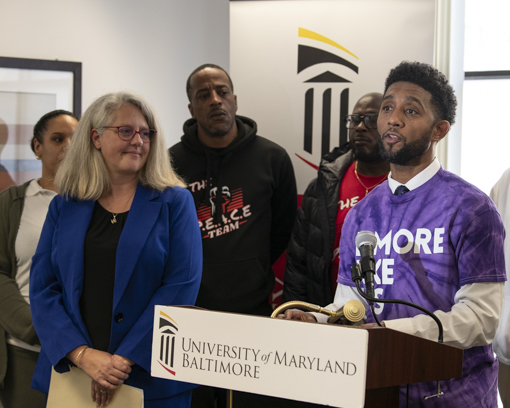Healing Civic Action: Embrace Resource Center Sparks Change
Pointing to local establishments near the University of Maryland, Baltimore (UMB), including the Hippodrome Theatre, CFG Bank Arena, and Lexington Market, UMB President Bruce E. Jarrell, MD, FACS, noted, “So goes the community around us, so goes UMB.”
Jarrell was speaking to assembled guests, who included Baltimore Mayor Brandon M. Scott, during the official opening of the Embrace Resource Center’s (ERC) new space at 55 N. Paca St. The Jan. 26 event highlighted the ongoing work of the UMB center, whose goal is to create and maintain a safe, thriving community for those living and working along the Eutaw Street corridor.
“It is, really, a very vibrant center,” Jarrell said, though he also acknowledged the challenges faced in the area. “But to be more vibrant, we need to make the people who work and live in this community be able to get resources to rehabilitate their lives when they need them.”

Dr. Kyla Liggett-Creel, Baltimore Mayor Brandon Scott, and Embrace Resource Center partners celebrate the opening of the center’s new space in January 2024.
The ERC, Jarrell said, was launched to help the Eutaw Street community with those needs, and he affirmed UMB’s commitment to the resource center and the neighborhood.
A partnership among UMB, local nonprofits, city agencies, and private-sector business owners, the ERC engages social workers and peer recovery specialists along with credible messengers with relevant lived experiences to collectively provide outreach to the local community. Their work — which includes case management, mediation, and peer support — seeks to confront the issues that cause violence and is modeled after a healing-centered engagement framework created by Shawn Ginwright, PhD, a professor at Harvard University.
As the ERC’s executive director, Kyla Liggett-Creel, PhD, LCSW-C, explained, “UMB believes in what Dr. Ginwright calls loving civic action, and the Embrace Resource Center is engaged in that loving civic action every single day.”
Liggett-Creel said in addition to being a place of collaboration, trust, and dignity, the ERC is one of results.
Among those results is a reduction in crime — since the resource center initiative was started in 2021, the surrounding area has seen a decrease in violent crime, as well as an 80 percent drop in the number of open-air drug sales.
In remarks made at the event, Scott noted the recent reduction in violence in Baltimore, and he credited collaborations such as the one that built the ERC for helping make that possible.
“The Embrace Resource Center is the living embodiment of ‘it takes a village.’ We talk about building a community violence intervention ecosystem — this is what we’re talking about. Every single aspect of what happens here is a part of that ecosystem,” Scott said.
He also said the ERC’s healing-centered approach is integral to successful efforts to address the root causes of violence.
“If you want to reduce something or have something go away temporarily, do it the quick way. But if you want it to be sustained over time, we have to do it the right way,” Scott said. “And this is the right way, making sure we see the individuals and its neighbors who are struggling with whatever they’re struggling with as humans.”
Marvin Garner, a credible messenger and peer recovery specialist at the ERC who made remarks at the event, spoke about the symbolism of the word “embrace” in the organization’s name. “Welcome with open arms — holding, hugging, and accepting without any doubt or without any reservations. This is the mantra in which we operate in this particular space,” he stressed.
Garner praised the ERC’s work, saying that more than 4,000 people in the community have been engaged through the center since 2021. Among those, he said, were 200 people who were assisted with job placement and 130 who were connected with drug treatment — of those, about 180 are still actively employed and 120 are still in the recovery process. Others in the community were helped with basic living supplies such as food, clothing, and baby items. The center also assists with shelter referrals, permanent housing, vital record applications, expungement, and transportation.
“You can’t expect a person to come off the corner if you can’t replace what they have with something equal or better,” Garner said, and added that the team at the ERC is “committed to replacing what people have considered to be ashes with beauty.”
Among those partnering with the ERC are UMB Police and Public Safety’s Community Outreach and Support Team, the mayor’s Office of Neighborhood Safety and Engagement, the Downtown Partnership, Baltimore Markets, and the local nonprofit P.E.A.C.E. Team.
Scott hailed the collaboration and called the ERC an example of what can be achieved when anchor institutions partner with city organizations.
“Congratulations on the work so far,” Scott said. “But we know there’s a lot more work to be done, and we all have to remain committed each and every day.”



